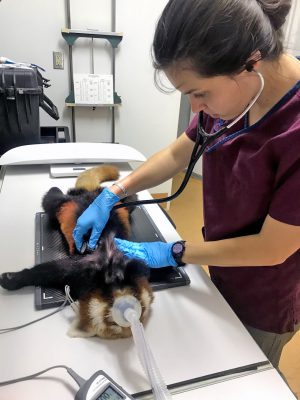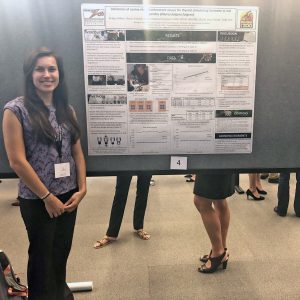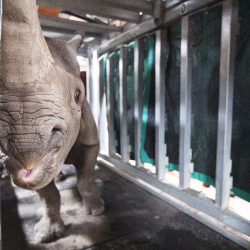By Bridget Walker, DVM Class of 2021

Bridget Walker, DVM Class of 2021, had an eventful summer—most of which she spent at Potter Park Zoo in Lansing, MI, and Binder Park Zoo in Battle Creek, MI. From performing physical examinations, assisting with anesthesia, drawing blood, and running clinical tests, to formulating treatment plans on animals ranging from small frogs to rhinos, Walker gained a great deal of experience. Experience that also extended into veterinary medical research. Her research subjects? Red pandas. Learn more about her experience with these unique animals, and how she’s helped to advance animal health, below.
I started working with red pandas at Potter Park and Binder Park in May of 2019. On my first day of work for the summer, I got to help with a pre-shipment examination on a male red panda named Rupert Jr. I was even given the opportunity to try for a blood draw! I also had the privilege of being able to assist with several other red panda examinations throughout the summer, but most of my involvement with them was through my research project on a red panda thyroid stimulating hormone.
Animals in facilities accredited by the Association of Zoos and Aquariums (AZA) commonly move around the country in order to coordinate breeding programs and keep these captive populations healthy and growing. Before these animals are moved, a thorough examination needs to be performed on them—including bloodwork, fecal parasite examinations, radiographs, ultrasounds, and other species-specific tests—to make sure the animal is healthy enough to travel. This also gives the new facility (the one that will be receiving the animal) a good baseline for the physical status of the animal so they can watch carefully for and recognize any health changes.
Specifically, I worked to validate the canine thyroid stimulating hormone (TSH), chemiluminescent immunoassay in red pandas—a diagnostic testing method that allows for accurate measurement of abnormal TSH concentrations, while also detecting thyroid disfunction. There are very few validated diagnostic tests for zoo species, so much of the diagnoses of these tests are extrapolated from domestic species. There has been evidence of thyroid dysfunction in captive red pandas, and the validation of a diagnostic test for thyroid function would help to identify these individuals.
To do this, we took serum samples from several red pandas at both Potter Park and Binder Park Zoo and submitted them to the Michigan State University Veterinary Diagnostic Laboratory (VDL). At the VDL, these samples were used in a validation study to determine how accurate the canine TSH assay is in the detection of TSH concentrations in red panda serum. From the samples we submitted, we were able to validate this assay, which is very exciting. We are currently collecting and testing more samples with this validation protocol to add to our existing data.
The MSU VDL was extremely vital to this research project. They ran all of our serum samples through the validation protocol and compiled the data for our study. They also provided invaluable input and information on the interpretation of these data.

Dr. Brian Petroff, section chief of Endocrinology for the Department of Pathobiology and Diagnostic Investigation at the MSU College of Veterinary Medicine, and Dr. Ronan Eustace, director of Animal Health at Potter Park Zoo, are the principle investigators behind this research. Dr. Petroff is an amazing endocrinologist who has experience validating endocrine tests in different species. Being able to sit down with him and discuss how the validation process is performed on different endocrine tests was very educational.
Working with Dr. Eustace also was a huge asset to my education and has helped me learn more about the zoo-veterinarian profession. He’s a fantastic teacher and explains not only “the what” of his decisions, but also “the why.” As a student, it’s extremely helpful to hear a doctor’s thought process and be taken through the steps of whatever treatment or test you are working on with them. He allowed me to have a huge amount of hands-on experience throughout the summer, which is invaluable, especially as I prepare to move on to the clinical portion of my education. I even got to do some of the blood draws for the red panda project!

For Potter Park, research projects like this one reaffirm the Zoo’s long-standing commitment to improving the health of zoo animals. For MSU, collaborating with the Zoo on a research project affords the VDL’s veterinary researchers an opportunity to work on a project that will help improve the health of endangered species. Very little is known about endocrine diseases in the red panda population and this project, by validating TSH, was the first step in unraveling thyroid diseases in this species. The next step will be to measure TSH in many healthy red pandas to create a reference range.
One of my favorite parts of working with the red pandas was being given the opportunity to add to what we know about red panda medicine. Doing research and sharing information with others is a very important aspect of being a zoo veterinarian. Being able to contribute just one small piece to the puzzle that is red panda medicine is very rewarding and inspires me to continue doing research in the future.

Being a student, I spend a lot of my time listening to lectures and reading class notes which, not surprisingly, can get a little bit dull. Being able to work with clinicians in the summer allows me to put the information I learn in class to use. A huge part of veterinary medicine is learning didactic materials in order to know things—like how the body works, anatomy, diseases, and drugs. But, in clinical practice, this knowledge can only get you so far. You have to get out there and get hands-on experience in order to be the best doctor you can be. I have always learned best when I am able to apply whatever I am trying to study, and the hands-on experience I gained at Potter Park with Dr. Eustace and at Binder Park Zoo with Dr. Kim Thompson gave me the opportunity to do so.
Wild red panda populations are declining due to habitat destruction, which makes having a healthy population of captive red pandas critically important. These research projects drive the knowledge on the diseases that affect captive red pandas, which can help improve the overall health and sustainability of these animals in captivity. If you have an interest in donating to our zoo student summer research fund, please contact Potter Park Zoo for more information.



